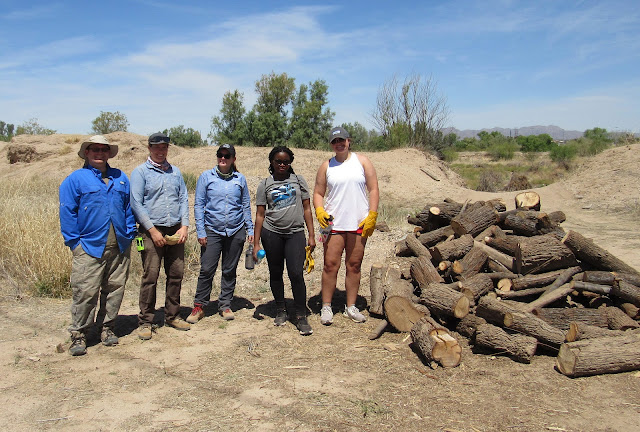Corazón: A Community's Effort to Protect the Heart of Tucson
By Rhianyon Larson
 |
| Some of the volunteer crew, photos by Rhianyon Larson |
Water is a lifeline in our desert homes. Not just to the 500,000+ people who live in Tucson, but also the thousands of species in the Sonoran Desert that depend on its ebbing flows and monsoon torrents.
Coming from Montana, a place with a creek bed and lakeside around every corner, I am amazed at the interconnected nature and vitality of the desert’s diverse landscapes. A vast, green network of washes teems with life that follows underground water flows—birds, rabbits, lizards, palo verde and mesquite. If you look closer at these washes, you’ll also see invasive species such as salt cedar and buffelgrass. These species subject native plants, like our symbolic, towering saguaro cactus, to future threats of unnatural fire and an intense competition of resources. And what would our desert be without the great saguaro and hundreds of other native species that bring such beautiful life to this region like nowhere else on Earth?
 |
| Piles of cut non-native trees dot the landscape |
The Corazón Sin Fuego Project, meaning Heart Without Fire, aims to restore and protect the valuable riparian habitat at the confluence of the Santa Cruz and Rillito Rivers, and the Canada del Oro wash. It symbolizes the immense importance of integrated community effort, involving funding and management from the Arizona Department of Forestry and Fire Management and Tucson Audubon Society. These partners share the aligning goals of protecting our community and desert wildlife from wildfire.
After learning of this project, I reached out to Urban Habitat Restoration Manager Kari Hackney and was greeted with great excitement. As it is with most non-profits and projects such as these, organizations thrive on volunteer help, and the Corazón was no exception. I experienced this for myself as I arrived on the work day and saw a massive portion of the Santa Cruz River covered in cut salt cedar logs. I couldn’t believe that this giant area was only one part of the 7-mile work zone. I was welcomed by a team of six, including members of Tucson Audubon, and to my excitement, members of the University of Arizona’s Blue Chip Leadership Club. It warmed my heart to see people my age, 18 or so, joining the cause and learning about the world around them. Some of them had never been birding and some had rarely ventured into the desert landscape, but they wanted to volunteer because they believed in the importance of the project.
 |
| Loading logs for transport |
In our time there, we moved countless pieces of chopped wood, adding to the ever growing pile of public use firewood. It was good work, the kind that makes you sweat a bit, but feels like an accomplishment in the end. It was a wonderful experience that left me thinking of the importance of conservation, restoration, and the integration of community effort. I could see the many values of the project in offering the wood to heat people’s homes and fuel summer campfires, protecting habitat vital to native birds and other wildlife, and educating people about the Sonoran Desert. Even with all of our work, we could see further work was needed—piles of trash were revealed as we cleared the area, and we immediately conceived the idea of organizing a clean up this fall.
 |
| Making a difference in the Sonoran Desert |
There is great power in exposing yourself to the natural world around you and even greater power and benefit in contributing to its restoration and conservation. We are so incredibly fortunate to live in such an inspiring and unique place, and I believe it’s up to us to save it. If not us, who will? I don’t see our sweet Gila Woodpeckers able to fend off the destruction of its home when a wildfire sweeps through. I’ve only recently entered into the world of birding, but I know one thing for certain: in order to admire, we must protect. You can truly make a difference, and the Earth will thank you!
Look for upcoming work days with the Corazón project and many other volunteer opportunities on Tucson Audubon’s website.
Rhianyon Larson is a current student at the University of Arizona studying Public Health. She is passionate about conservation and sustainability, and is interested in the intersection of humans and the health of the natural world. Being a beginner in birding, she is constantly learning about the species around us and the importance of our actions on their lives.

Comments
Post a Comment
Thanks, we value your opinions! Your comment will be reviewed before being published.